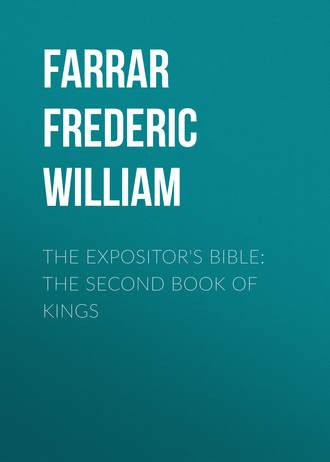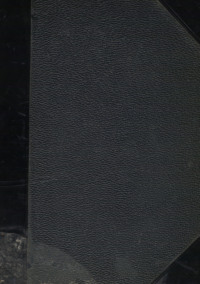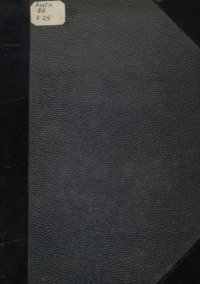 полная версия
полная версияThe Expositor's Bible: The Second Book of Kings
459
See Ovid, Fasti, v. 659: "Scripea pro domino Tiberi jactatur imago." They were also called Argei, id. 621; Varro, L. L., vi. 3.
460
Varro, L. L., v. 3.
461
Herod., ii. 137. Egypt., Sebek; Heb., So (2 Kings xvii. 4), or perhaps Seve; Arab., Shab'i. Rawlinson, Hist. of Anct. Egypt, ii. 433-450.
462
Kir (see Amos ix. 7) is omitted in the LXX. Elam is added in Isa. xxii. 6. Tiglath-Pileser calls the king Rasunnu Sarimirisu —i. e., of Aram. See Smith, Assyr. Discoveries, p. 274; Eponym Canon, 68; Schrader, K. A. T., 152 ff.
463
Isa. xvii. 1-11.
464
The name seems to be Tuklat-abal-isarra, – according to Oppert worshipper of the son of the Zodiac —i. e., of Nin or Hercules. According to Polyhistor, he was a usurper who had been a vine-dresser in the royal gardens. He never mentions his ancestry. But see Schrader, K. A. T., 217 ff., 240 ff., and in Riehm.
465
Eponym Canon, p. 121, lines 1-15. On this fall of Damascus and Samaria, see Isa. xvii.
466
Jahuhazi (Schrader, Keilinschr., p. 263). He probably bore both names; but, as in the case of Jeconiah, who is called Coniah, the omission of the element "Jehovah" from his name may have been intended as a mark of reprobation.
467
The remark may refer to some earlier period in the reign of Ahaz, before the capture of Damascus. It is more probable that the altar was used for some Assyrian deity, and the adoption of it may have flattered Tiglath-Pileser.
468
2 Kings xvi. 11, which records the zealous subservience of Urijah, is wanting in some MSS. of the LXX. But that the altar was made, and without his opposition, is clear from the narrative. Asa (2 Chron. xv. 8) had repaired Solomon's great altar; Hezekiah subsequently cleansed it (id. xxix. 18); Manasseh rebuilt it (Q'ri). The brass of it ultimately went to Babylon (Jer. lii. 17-20).
469
Bähr says: "It seems that Urijah, like his companion, was only anxious for his revenues. At any rate, his conduct is a sign of the character and standing of the priests of that time. They were 'dumb dogs who could not bark.' They all followed their own ways, every one for his own gain" (Isa. lvi. 10, 11). "We have in this high priest," says the Würtemberg Summary, "a specimen of those hypocrites and belly-servants who say, 'Whose bread I eat, his song I sing'; who veer about with the wind, and seek to be pleasant to all men; who wish to hurt no one's feelings, but teach just what any one wants to hear."
470
1 Kings viii. 64; 2 Chron. iv. 1. In this and similar instances commentators, biassed by a priori considerations, have imagined that Ahaz did not in person offer sacrifices. But this is what the text says, and it was the custom of kings to regard themselves as invested with Divine attributes. Ahaz may have had this lesson impressed on his mind by his visit to Tiglath-Pileser. See Grätz, Gesch. der Juden., ii. 150. Layard, Nin. and Bab., 472 ff., gives us pictures of Assyrian kings ministering at their altars, which are of various shapes.
471
2 Kings xvi. 15. Vulg., paratum erit ad voluntatem meam. The LXX. followed another reading: ἔσται μοὶ εἰς τὸ πρωί. Grätz (ii. 150), for לכקר, "to inquire," reads לקרב "to draw near to."
472
1 Kings vii. 23-39.
473
2 Kings xvi. 18. The allusions are obscure. R.V., "the covered way"; A.V., "the covert for the Sabbath." See 2 Chron. ix. 4. Here the Hebr. Q'ri has Mûsak, and the Vulg. Musach Sabbati. The LXX. evidently did not understand it (καὶ τὸν θεμέλιον τῆς καθέδρας ᾠκοδόμησεν). For "covert for the Sabbath," Geiger suggests "molten images for the Shame" (Bosheth-Baal, by transposition of Shabbath). Comp. 2 Chron. xxviii. 2.
474
2 Chron. xxviii. 20: "Tiglath-Pileser came unto him, and distressed him, but helped him not."
475
2 Kings xviii. 15, 16.
476
In justice to Ahaz, we should observe that (1) in every instance the later account multiplies and magnifies and gives a darker colouring to his offences; (2) that neither Isaiah, Micah, nor any other prophet has a word of reproach for such enormities in Ahaz.
477
It is a Jewish tradition that Hezekiah would not bury his father Ahaz in a sarcophagus, but on a bier (Pesachin, f. 56, 1; Sanhedrin, f. 47, 1; Grätz, Gesch. d. Juden., ii, 224).
478
His name, Chizquîyyah, is shortened from Yechizquîyyahoo (Isa. i. 1; 2 Kings xx. 10; Hos. i. 1). It means "Jehovah's strength" (Gesen.), or "Yah is might" (Fûrst).
479
The first of these dates is highly uncertain, as is the entire chronology of this reign. I follow Kittel.
480
2 Chron. xxxi. 2-21.
481
Josiah did this many years later (2 Kings xxiii. 13).
482
Gen. xxxv. 14. See Spencer, De legg. Hebr., i. 444; Bochart, Canaan, ii. 2.
483
Exod. xxiv. 4. Comp. Deut. vii. 5, xii. 3, xvi. 22; Lev. xxvi. 1; 2 Chron. xiv. 3, xxxi. 1; Jer. xliii. 13; Hos. x. 2; Mic. v. 13 (where the A.V. often has "statue" or "image"). Comp. Clem. Alex., Strom., i. 24; Arnob., c. Gent., i. 39.
484
The rendering "grove" in the A.V. is borrowed from the ἄλσος of the LXX., and the lucus of the Vulgate. On the connection of the Asherah with the sacred tree of the Assyrian, see my article on "Grove" in Smith's Dict. of the Bible; and Fergusson, Nineveh and Persepolis Restored, 299-304. On the worship of Asherah, see 1 Kings xv. 13; 2 Kings xxi. 3-7, xxiii. 4; 2 Chron. xv. 16; Judg. iii. 5-7, vi. 25, xviii. 18. Baudissin in Herzog Realencykl., s. v. We may well be startled by the prevalence of idolatry in Jerusalem revealed in Isa. x. 11, xxvii. 9, xxix. 11, xxx. 9, 22, etc.
485
See Wellhausen, Hist., 235; Stade, Gesch. d. V. I., 460; W. R. Smith, Religion of the Semites, 171; Cheyne, Isaiah, ii. 303; Renan, Hist. du Peuple d'Israel, i. 230 (Prof. Driver, Bibl. Dict., i. 258, 2nd edition).
486
Hierozoicon, ii. 3, § 13.
487
Jer. xliv. 17. In the collection of antiquities of Baron Ustinoff at Jaffa are five or six dragon-headed serpents, with ears of copper and hollow inside. They are ancient, and were perhaps used as talismanic copies of Nehushtan.
488
If this was a genuine relic, it must have been nearly eight hundred years old. It is never mentioned elsewhere.
489
נְחֻשׁתָּן, "a brazen thing." The king certainly showed a horror of sacerdotal imposture and religious materialism. Yet Renan argues, from Isa. x. 11, xxvii. 9, xxx. 9, 22, that he must have had a certain amount of tolerance. See Hist. du Peuple d'Israel, iii. 30.
490
2 Kings xviii. 4. Vayyikra is like the English indefinite plural. The impersonal rendering (as in other passages) is adopted in the Targum of Jonathan, the Peshito, etc., and by Luther, Bunsen, Ewald, and most moderns.
491
This relic is still shown in the Church of St. Ambrose at Milan. It used to be the popular notion that it would hiss at the end of the world. The history of the Milan "relic" is that a Milanese envoy to the court of the Emperor John Zimisces at Constantinople chose it from the imperial treasures, being assured that it was made of the same metal that Hezekiah had broken up (Sigonius, Hist. Regn. Ital., vii.). It is probably a symbol used by some ophite sect. See Dean Plumptre, Dict. of Bibl., s. v. "Serpent."
492
2 Kings xvi. 8; Driver, Isaiah, 68.
493
The diverting of the water-courses enabled him to bring the water into the city by a subterranean tunnel. The Saracens took a similar precaution (Gul. Tyr., viii. 7). See Appendix II., where the inscription is given; and compare 2 Chron. xxxii. 30. Apparently it carried the water of Gihon to the south-east gate, where were the king's gardens. Ecclus. xlviii. 17: "Ezekias fortified his city, and brought in water into the midst thereof: he digged the hard rock with iron, and made wells for water." For "water" the MSS. read "Gog," a corruption probably for ἀγωγὸν, "a conduit" (Geiger) or "Gihon" (Fritzsche).
494
Psalm xlvi. 1-11.
495
2 Chron. xxviii. 18.
496
2 Kings xviii. 8: comp. xvii. 9. Josephus says that he failed to take Gath (Antt., IX. xiii. 3).
497
A.V., "treasurer" (soken; lit., "deputy" or "associate": Isa. xxii. 15). He was "over the household." The Egyptian alliance had for Judah, as Renan points out, some of the fascination that a Russian alliance has often had for troubled spirits in France (Hist. du Peuple d'Israel, iii. 12).
498
Renan says that he may have been a Sebennyite, and his name Sebent.
499
Isa. xxii. 17, 18: "Behold, the Lord shall sling and sling, and pack and pack, and toss and toss thee away like a ball into a distant land; and there thou shalt die" (Stanley). The versions vary considerably.
500
Isa. xxxvii. 2. There can be little doubt that there were not two Shebnas.
501
Mic. i. 10-16. See the writer's Minor Prophets ("Men of the Bible" Series), pp. 130-133, for an explanation of this enigmatic prophecy.
502
Jer. xxvi. 8-24. He tells us that the prophecy was delivered in the reign of Hezekiah. See my Minor Prophets, pp. 123-140.
503
Isa. x. 28-32. It would involve a cross-country route over several deep ravines —e. g., the Wady Suweinit, near Michmash. In 1 Sam. xiv. 2, Thenius, for "Migron," reads "the Precipice." Some take Aiath for Ai, three miles south of Bethel. Renan says (Hist. du Peuple d'Israel, iii.): "Nom d'Anathoth, arrangé symboliquement."
504
Isa. x. 14. The metaphor of a bird's nest occurs more than once in the boastful Assyrian records.
505
Isa. xxx. 1-7. Rahab means "fierceness," "insolence." For the various uses of the word, see Job xxvi. 12; Isa. li. 9, 10, 15; Psalm lxxxix. 9, 10, lxxxvii. 4, 5.
506
See Dr. S. Cox (Expositor, i. 98-104) on Isa. xxviii. 7-13.
507
Acts xvii. 18.
508
Isa. xxviii. 7-22.
509
Professor Smith, Isaiah, i. 12.
510
Bagehot, Physics and Politics, p. 73; Smith, Isaiah, 109.
511
One of the first to point out the necessary rearrangement of the events of Hezekiah's reign was Dr. Hincks, in his paper on "A Rectification of Chronology which the newly discovered Apis-stêlês render necessary" (Journ. of Sacred Lit., October 1858). See my article on Hezekiah, Smith, Dict. of the Bible, 2nd ed., ii. 1251.
512
Heb., sh'chîn; LXX., ἕλκος; Vulg., ulcus.
513
The Rabbis even make his sickness the punishment for his having neglected to secure an heir. He pleads that he foresaw the wickedness of his son. Isaiah tells him not to try to forestall God (Berachoth, f. 10, 1).
514
Isa. xxxviii. 10-20.
515
Comp. 1 Kings xxi. 4 (Ahab).
516
2 Kings xx. 4. The Q'rî or "read" text is, as here rendered, chatsee (comp. 1 Kings vii. 8), and is followed by the LXX. (ἐν τῇ αὐλῇ τῇ μέσῃ), by the Vulgate (mediam partem atrii), and by the A.V. The R.V., which adopts the Kethîb or written text, ha'îr, renders it "the middle part of the city." If this be the true reading, it would mean that Isaiah had gone some distance from the palace, and was now perhaps in the Valley between the Upper and the Lower City. But it seems not improbable that (1) "the steps of Ahaz" would be in the royal court, and (2) the answer of God, like the mercy of Christ to the suffering, may have come promptly as an echo to the appealing cry.
517
The LXX. calls "the stairs" ἀναβαθμοὺς τοῦ οἴκου τοῦ πατρός σου, and so, too, Josephus (Antt., X. ii. 1). The Targum calls them "an hour-stone." Symmachus has, στρέψω τὴν σκίαν τῶν γραμμῶν ἥ κατέβη ἐν ὡρολογίῳ Ἀχάζ.
518
It should, however, be observed that on the question of priority critics are divided. Grotius, Vitringa, Paulus, Drechsler, etc., thought that the account in the Book of Isaiah is the original; De Wette, Maurer, Koster, Winer, Driver, etc., regard that account as a later abbreviation, perhaps from a common source.
519
See Professor Lumby, ad loc.
520
There is an exactly similar sun-dial not far from Delhi.
521
Journ. of Asiatic Soc., xv. 286-293.
522
Figs have a recognised use for imposthumes. See Dioscorides and Pliny quoted in Celsius, Hierobot., ii. 373. In the passage of Berachoth quoted above, Hezekiah in his sickness asks Isaiah to give him his daughter in marriage, that he may have an heir. Isaiah replies that the decree of his death is irrevocable. The king bids Isaiah depart, and says (quoting Job xiii. 15) that a man must not despair, even if a sword is laid on his neck.
523
Comp. Psalm xlii. 4.
524
Isa. xxxviii. 10-20.
525
The Babylonian form of his name is Marduk-habal-iddi-na —i. e., "Merodach gave a son." He is the Mardokempados of the Ptolemaic Canon, and the second fragment of his reign (six months) is mentioned by Polyhistor (ap. Euseb.). Josephus calls him Baladan (Antt., X. ii. 2). He was originally the prince of the Chaldæan Bit Yakîm. Sargon calls him "Merodach-Baladan, the foe, the perverse, who, contrary to the will of the great gods, ruled as king at Babylon." He displaced him for a time by "Belibus, the son of a wise man, whom one had reared like a little dog" (as we might say "like a tame cat") "in my palace" (Schrader, ii. 32). In the Assyrian records he is often called (by mistake?) "the son of Yakim." For the adventures of the Babylonian hero, see Schrader, K. A. T., 213 ff., 224 ff., 227, and in Riehm, Handwörterbuch, ii. 982.
526
Isa. xiv. 4, xiii. 19.
527
Gen. x. 10, 11, xi. 1-9.
528
Jos., Antt., X. ii. 2: Σύμμαχόν τε αὐτὸν εἶναι παρεκάλει καὶ φίλον.
529
2 Kings xx. 13. LXX., ἐχάρη.
530
See Dan. i. 6.
531
2 Chron. xxxiii. 11.
532
Job i. 21.
533
Manasseh seems to mean "one who forgets." See Gen. xli. 51. It was the name of the husband of Judith (Judith viii. 2), and is found in Ezra x. 30, 33.
534
One legend of his birth resembles the finding of Moses in the bulrushes.
535
Schrader, K. A. T., pp. 272-274; Records of the Past, vii. 28.
536
Smith, Eponym Canon, p. 130.
537
See Prof. Smith, Isaiah, p. 198.
538
Records of the Past, vii. 40. Sargon's words are, "The people of Philistia, Judah, Edom, and Moab were speaking treason. The people and their evil chiefs, to fight against me, unto Pharaoh, the King of Egypt, a monarch who could not save them, their presents carried, and besought his alliance" (G. Smith, Assyrian Discoveries, 290).
539
On the monuments called Turtanu, "Holder of power." See Schrader in Riehm, s. v.
540
Raphia, or Ropeh, is on the borders of the desert. Asia beat Africa in every encounter – at Raphia, at Altaqu, at Carchemish. The impression of the seal of Shabak, attached to his capitulations with Sargon, was found at Nineveh by Sir A. H. Layard, and is now in the British Museum. Shabak died in 712. His son Shabatoh succeeded him in Egypt, and his nephew(?) Tirhakah in Ethiopia. Sabaco's name assumes many forms (LXX., Σηγώρ; Herod., ii. 137; Σαβακώς; Vulg., Sua). The Egyptians called him Shaba(ka).
541
Isa. xx. 1-6.
542
Lenormant, Les Premières Civilisations, ii. 203; Records of the Past, vii. 41-46.
543
Isa. xxi. 6, A.V., "Watch in the watch-tower." Hitzig, Cheyne, "They spread the carpets." Much in this short oracle (xxi. 1-10) is obscure. Isaiah seems, in denouncing the fate of Babylon, to mourn for the ruin of the smaller states of which it was the prelude (G. Smith, Soc. of Bibl. Arch., ii. 320 Kleinert, Stud. u. Krit., 1877 W. R. Smith in Enc. Brit., s. v. "Isaiah").
544
Isa. xxi. 10 —i. e., "My people threshed and trodden"; LXX., ὁ καταλελειμμένος καὶ οἱ ὀδυνώμενοι Records of the Past, vii. 47.
545
Herod., Σαναχάριβος; Jos., Σεναχήριβος. See Appendix I. Sin was the moon-god; Merodach, the planet Jupiter; Adar, Saturn; Ishtai, Venus; Nebo, Mercury; Nergal, Mars (Schrader, ii. 117).
546
Sargon seems to have been murdered in the palace of unparalleled splendour which he built at Dur-Sharrukin ("The City of Sargon"). It took him five years to build it with armies of workmen. Its halls, opened by Botta, were the first Assyrian halls ever entered by a modern's foot. It is strange that this greatest of Assyrian kings is only mentioned once in the Bible (Isa. xx. 1). We owe to Assyriology his restoration to his proper place in the annals of mankind. See Ragozin, Assyria, 247-254.
547
Rawlinson, Ancient Monarchies, ii. 178.
548
Canon Rawlinson, Kings of Israel and Judah, 187.
549
On his own monuments this campaign, except its final catastrophe, is narrated in four sections: (1) The subjugation of Phœnicia, and of Philistine towns; (2) the conquest of King Zidka of Askelon; (3) the defeat of Ekron, the restoration of their vassal king Padî to his throne, and the defeat of Egypt at Altaqu; (4) the expedition against Jerusalem (Schrader, E. Tr., i. 298). See Appendix I.
550
This allusion is said to be the only instance of humour – "grim humour, or it would not be Assyrian" – which occurs in the Assyrian annals.
551
Schrader, pp. 234-279. The account of the memorable campaign is narrated in duplicate on the Taylor Cylinder in the British Museum, and on the Bull Inscription at Kouyunjik.
552
Sennacherib calls Tirhakah's army "a host that no man could number"; but it was defeated by the better discipline, the heavier armour, and the superior physical strength of the Assyrians.
553
See Josh. xix. 43.
554
This very phrase "I imposed on them" is found on Sennacherib's monument (Schrader, ii. 1). The references, when not otherwise specified, are to Whitehouse's English translation.
555
In 2 Kings xviii. 16 the word "pillars" or "doorposts" is uncertain. LXX., ἐστηριγμένα; Vulg., laminas auri.
556
2 Chron. xxxii. 9. He had to besiege it "with all his power." He seems to have thought it even more important than Jerusalem, for he superintended the siege in person (Layard, Nineveh and Babylon, 150; Monuments of Nineveh, 2nd series, pl. 21). The ruined Tel of Umm-el-Lakîs lies between the Wady Simsim and the Wady-el-Ahsy (Riehm).
557
See 2 Chron. xi. 9, xxv. 27; Jer. xxxiv. 7. The allusion to this city in Micah (i. 13) is obscure: "O thou inhabitant of Lachish [swift steed], bind the chariot to the swift steed: she is the beginning of sin to the daughter of Zion: for the transgressions of Israel were found in thee." This seems to imply that some form of idolatry had come from Israel to Lachish, and from Lachish to Jerusalem. In Sennacherib's picture of the city, foreign worship is represented as going on in it (Layard, Monuments of Nineveh, Pls. 21 and 24; Rawlinson, Herodotus, i. 477).
558
Isa. xxix., xxx., xxxi.
559
Isa. xxxiii. 8.
560
Isa. xx. 1.
561
Jer. xxxix. 3. The meaning of the name is not certain. Sarîs, in Hebrew, is "eunuch"; but the word is not known in Assyrian records, and we should expect Rabsarîsîm, as in Dan. i. 3.
562
Rabsak perhaps means chief officer or vizier, and is Hebraised into Rabshakeh. Prof. G. A. Smith (Isaiah, p. 345) calls him "Sennacherib's Bismarck." Rabshakeh, usually rendered "chief cupbearer," is an Aramaised form of Rabsak (great chief); but we know of no chief cupbearer at the Assyrian court (Schrader, K. A. T., 199 f.).
563
From an Apis-stêlê he seems to have reigned twenty-six years (b. c. 694-668?).
564
Isa. xxii. 1-13.
565
Eliakim. See Isa. xxii. 21, 22.
566
"Vain words"; lit., "a word of the lips." LXX., λόγοι χειλέων.
567
Comp. Isa. xxx. 1-7; Ezek. xxix. 6. It seems to be an over-refinement to suppose that Sennacherib refers to the divisions between Egypt and Ethiopia.
568
2 Kings xviii. 23, A.V.: "Let Hezekiah give pledges."
569
Heb., Arâmîth.
570
2 Kings xviii. 28, where stood should be rendered came forward.
571
The coarse expression is softened down by the Chronicler (2 Chron. xxxii. 18).
572
The kings of Assyria usually called themselves "great king, mighty king, king of the multitude, king of the land Assur."





